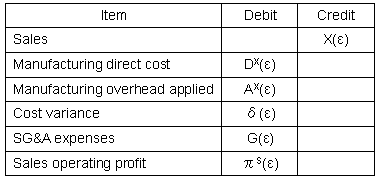| Part
1 Management
Accounting
|
|
| §1 Derivation of the managed gross profit chart and the 45
degree break-even chart under absorption costing |
|
| Yuichiro
Hayashi, Y. Hayashi |
|
The
CVP analysis or the break-even analysis
is easily possible in business accounting under
standard costing or absorption costing. |
|
| This
section describes
the main points of the references (1) and (2). |
|
| The
reference (1), an invention applied for in 1997 as a business patent to the JPO
is termed the "1st
invention". The reference (2), the U.S. patent is termed the "2nd invention". |
|
| Cost accounting is
classified into main branches of
both absorption costing or full costing (a representative example: standard costing)
and direct costing or variable costing. The big difference between the two
costings is the treatment
of manufacturing
overheads (fixed indirect cost) for product costs. In absorption costing,
the manufacturing overheads are distributed to goods sold and
inventories by allocation. In direct costing, it is treated as a period
cost in the same way as selling, general and administrative
expenses (SGA), and so it is not distributed to inventories. |
|
| An
income statement for financial accounting is ultimately made on the basis of absorption costing. The 1st and the 2nd inventions relate to
charting the income statement under
absorption costing.
Both the 1st invention and the 2nd invention use the concept of the “managed-gross-profit” denoted by the symbol QM is used as a profit
management target in management accounting. The
symbol QM
is defined as: QM = sales −
manufacturing direct costs −
manufacturing overhead applied. The QM chart is termed the” managed gross
profit
chart”. In this chart the
operating profit on an income statement (referred to as "the sales operating
profit" ) is shown including the managed
gross profit. |
|
| In the 1st invention, a charting method for the
managed-gross-profit chart for an overall company is described. In this
invention, a
break-even point which is shown in the managed gross profit chart is indicated, and the
author has
given a new, correct, break-even sales formula.
|
|
| In the 2nd
invention, a break-even chart, under absorption costing, expressed as a
45-degree line chart is presented. In addition, a method of drawing the
managed gross profit chart of each operating
department in a company
is presented. |
|
| For
simplicity, we assume that manufacturing direct costs are actual costs. Manufacturing
overhead is allocated to goods sold and inventories based on the predetermined
allocation basis: manufacturing overhead applied = manufacturing overhead application rate
× basis amount for allocating overhead. The symbol (ε)
is added to any symbol X like X (ε) to show that
X (ε) is a figure
on a final income statement. Superscripts X and
Y are used when cost items concern goods sold and goods manufactured,
respectively. |
|
|
The following notations are used
per one company:
X=sales
DX=manufacturing
direct costs( actual and variable costs)
C=manufacturing
overhead ( actual and fixed costs)
G=selling, general and administrative
expenses (SGA) ( actual and fixed costs)
AX=manufacturing
overhead applied to goods sold including
beginning inventories
AY=manufacturing
overhead applied to goods manufactured including
ending inventories
EX=(DX+AX)
= manufacturing
full cost of goods sold
QS=gross
profit for goods
sold or sales gross
profit
πS=operating
profit for goods
sold or sales operating
profit
|
|
| Manufacturing
overhead applied
included in goods sold is represented by the symbol AX (ε).
At the beginning of a fiscal year, the manufacturing overhead applied in a carried-down
inventory is represented by the symbol AX(−)(ε). At
the end of the fiscal year, that in a carried-forward inventory is shown by the symbol AY(+)(ε).
The
manufacturing overhead applied, which
is not included in inventories, is denoted as the symbol AX (0) (ε) or
AY
(0) (ε). The
symbols DX(−),
D X(0) and
DX (+) are defined similarly. The
relationships between these symbols are shown in Fig. 1-1. |
|
|
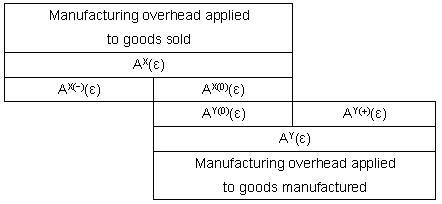
|
| Fig.
1- 1 Relationships between applied manufacturing overhead
costs
|
|
|
The
difference between A(−)(ε) and A(+)(ε) is
defined by the symbol η (ε):
|
|
η (ε)
= AX(−)(ε) −
AY (+)(ε)
|
|
|
= AX (ε) −
AY (ε) |
(1-1)
|
| The
symbol η (ε)
is called the "net carryover manufacturing overhead applied in
inventories".
|
|
| The manufacturing full cost
EX of goods sold is defined as follows: |
|
EX =
DX+AX |
(1-2) |
|
| Further, we define the "managed gross profit QM"
as follows: |
|
QM= X − EX
|
(1-3) |
| In the case where the symbol (ε)
is not used in e.g. X, X refers to a value during the period. |
|
| In addition, the following
notation is defined: |
|
πM
(ε) = QM(ε) − G(ε) |
(1-4)
|
| ,where πM(ε)
is called the "managed operating profit". |
|
|
As the
manufacturing overhead applied corresponding to the actual cost C (ε) is AY
(ε), cost variance δ (ε) in a manufacturing overhead department is
expressed
as: |
|
δ
(ε)
= C (ε) − AY (ε) |
|
|
= C (ε)
− (AX (ε) − η (ε)) |
(1-5)
|
| ,where δ
(ε)
is positive when the manufacturing overhead applied is under-estimated comparing
to C (ε) . When we directly charge
δ
(ε) to the current
sales, the manufacturing
overhead in goods sold is shown in Fig.1-2.
|
|
|
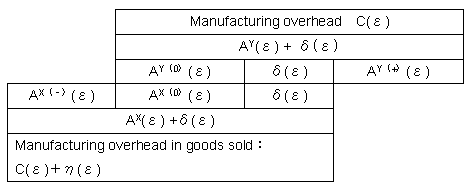
|
|
|
|
Fig.1-2 Manufacturing
overhead in goods sold
|
|
| Table
1-2 Income statement-2
|
|
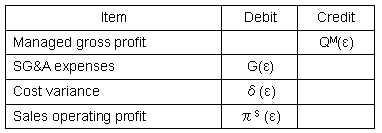
|
|
| From Eq.
(1-5) and Eq. (1-6), we have: |
|
|
πS(ε)
= QM (ε)+AX
(ε) − (η (ε)+C
(ε) +G (ε))
|
(1-8)
|
| Eq.(1-8)
shows that the following relationship shown in Table 1-3 exists.
|
|
| Table
1-3 Income
statement-3 |
|
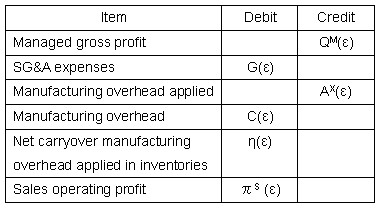
|
|
|
The purpose
of the managed gross profit chart theory is charting Eq. (1-8). When
we want to draw the break-even chart under absorption costing at the end
of an accounting period, we must previously determine the line shapes of
all costs from X=0 to X=X(ε)
on the horizontal axis. Letting X be a variable of sales,
both
AX (X) and
AY (X) can be expressed with a
combination of variable functions and
constants. What shape is the function η(X)
= AX(X) − AY(X)?
It is clear that the shape of η(X) is
an important point in order to draw the break-even chart under absorption
costing. |
|
| Both the 1st and the 2nd inventions resolved
this problem. In conclusion, η(ε)
becomes the constant which is determined by η(ε)
= AX(X) −
AY(X)=AX(−)(ε) − AY(+)(ε).
That is to say, we can regard η(ε)
as a fixed cost. Details are given in the section, "The
cause of Solomons's error in his break-even chart for absorption costing", §5,
Part 1 on this website. |
|
| A X
(ε)
is determined based on an allocation basis. In charting Eq. (1-8), classifying the
following two cases for A X (ε) is
possible:
|
|
| (1)
A X (ε) is proportional or quasi-proportional for sales X (ε).
The manufacturing overhead applied of this case is called the “1st
kind of manufacturing overhead applied”, and the notation of A
XI (ε)
is used.
|
|
| (2)
A X (ε) is constant or quasi-constant for X (ε).
The manufacturing
overhead applied of this case is called the "2nd kind of
manufacturing overhead applied”, and the notation of A XII (ε) is
used.
|
|
|
Based upon
this classification, the following notation is used:
|
|
|
A XI, II (ε)
= AX
(ε)
|
|
|
= AXI
(ε) + A XII (ε) |
(1-9) |
|
|
| If
we also adopt the same classification for C (ε), we obtain, from
Eq. (1-7), the
following equation:
|
|
πS(ε)
=QM (ε) +A XI (ε) +A XII (ε)
- (η I, II (ε) + C I, II (ε) + G (ε)) |
(1-10) |
|
| As both C (ε)
and G (ε) are fixed costs, Eq. (1-9) becomes:
|
|
πS(ε)
= QM (ε) +AX I (ε)
-
f (ε) |
(1-11)
|
|
f
(ε) =
f C (ε)
- A XII (ε) |
(1-12)
|
|
f C (ε)
=
η I, II (ε) + C I, II (ε) +
G (ε)
|
(1-13)
|
|
| A
marginal condition of QM (ε) in Eq. (1-10) occurs when
πS(ε)
=0.
Under this state, QM (ε) is represented with subscript
ξ as in Q M ξ (ε) . Thus Q M ξ (ε) can be
given by:
|
|
Q M
ξ (ε)
= f (ε) - X (ε) · tan α (ε)
|
(1-14)
|
| ,where
|
|
|
tan
αXI (ε) = A XI (ε) / X (ε)
|
(1-15)
|
| Transforming
Eq. (1-14) gives
|
|
|
Q
M
ξ
(ε)
/ f (ε) + X (ε) / (f (ε) / tan α (ε))=1
|
(1-16)
|
|
| Rectangular
coordinates with the horizontal axis X and the vertical axis QM will
be set. It is found that the point (Q M
ξ (ε), X (ε)) is
placed on the following line at X= X (ε):
|
|
QM
/ f (ε) + X / (f (ε) / tan α
(ε))=1
|
(1-17)
|
|
|
| From Eq.
(1-14) and
Eq. (1-5) , we obtain
|
|
|
QM
ξ (ε) = GF (ε) + δ (ε)
|
(1-18)
|
| From Eq.
(1-11), Eq. (1-5) and
Eq. (1-18), we have: |
|
|
πS(ε)
= QM
(ε) − Q Mξ
(ε)
|
(1-19)
|
|
| From Eq.
(1-3)
, we have:
|
|
|
QM
(ε) = X (ε) − DX
(ε) − A XI
(ε) − A XII
(ε)
|
(1-20)
|
| When
X (ε) =0 in Eq. (1-20), the following equation is satisfied:
|
|
|
QM
(X=0) = − A XII
(ε)
|
(1-21)
|
| Therefore,
QM
(ε) is written as:
|
|
|
QM
(ε) = − A XII
(ε) + tan β (ε) ·X (ε) |
(1-22)
|
| ,where |
|
|
tan
β (ε) = ( A XII
(ε) + QM
(ε) ) / X (ε) |
(1-23)
|
|
| The
managed gross profit chart consisting of the above-mentioned equations is shown
in Fig. 1-3. Line-1 shows Eq. (1-16). The line is referred to as the “marginal
managed gross profit line”. Line-2 shows Eq. (1-22). The line is referred to as
the “managed gross profit ratio line”. Line-3 shows Eq. (1-6).
Line-3 is
referred to as the “managed gross profit line”.
It should be noted that the slope of Line-2 is not equal to the ratio QM
(ε) / X (ε) in the defined technical term when AXII
(ε) exists.
|
|
| Fig.
1-3 Managed gross profit chart |
|
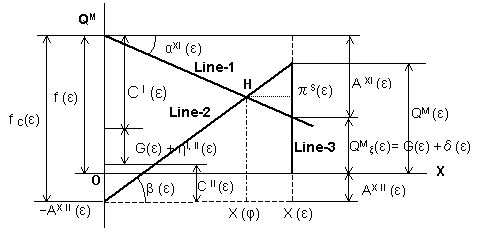
|
|
|
In
Fig.3, the intersection point H of Line-1 with Line-2 is the break-even point
in absorption costing. If we denote the break-even sales by X (φ), X (φ) is
given as the solution of Eq. (1-16) and Eq. (1-22) as follows:
|
|
|
X (φ)
/ X (ε)= ( η (ε) I, II + C I,
II F (ε) + G F (ε) )
/ (X (ε)
- DX (ε))
|
(1-24)
|
|
| Eq.
(1-24) is different from Solomons’s formula known as the break-even sales in
absorption costing. The author( Hayashi)
carefully compared his theory and Solomons's theory with the ' Break-
even line theory' which was the fundamental theory for this problem. He
has verified that his theory is consistent with the break-even line
theory but Solomons's theory is not. Therefore, Solomons's
formula is wrong. Detailed descriptions can be found in Reference (2). |
|
| Fig. 1-4 shows a 45° break-even chart using the same accounting
items as shown on Fig.
1-3.
It is proved in Reference (2) that the break-even sales X (φ) on
Fig. 1-3 and Fig. 1-4 are equal to each other. If η I, II (ε)=0 in
Fig. 1-4, Eq. (1-24) reduces to the well-known breakeven sales formula in
direct costing.
|
|
|
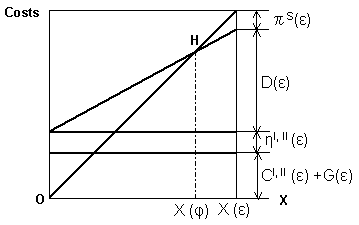
|
| Fig.1-4
45° Break-even
chart in absorption costing
|
|
|
| The
relationship between the 45° break-even chart and the managed gross
profit chart is shown in Fig. 1-5. |
|
|
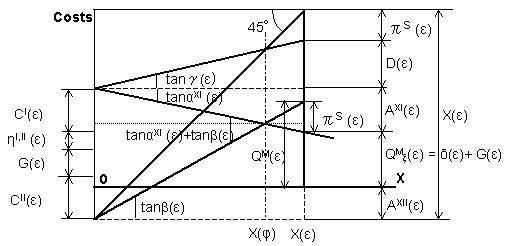
|
| Fig.1-5
Relationship between
45° break-even chart and managed gross
profit chart |
|
| The
following equations hold: |
|
tan αXI
(ε) + tan β (ε)=(X (ε)
- DX
(ε) ) / X (ε)
(1-25) |
|
tan αXI
(ε) + tan β (ε) +
tanγ(ε) =
1
(1-26) |
|
πS(ε)
=
(X (ε)
- X(φ))
(
tan αXI (ε) + tan β (ε))
(1-27) |
|
QM
(ε)
= πS(ε) /(1 - Q M
ξ
(ε) /
QM
(ε))
(1-28) |
|
| The author claims the following: |
| (1)
The brake-even sales formula under absorption costing, including
standard costing, has been presented by D. Solomons (1968), and now can
be found in any accounting textbook. Absorption costing is now
used for public disclosure and usually used in firms' accounting. The break-even
sales formula by
D. Solomons is wrong. A correct formula has been presented by the
author( Y. Hayashi) and this is shown in Eq. (1-24). |
|
| (2) Two
methods transforming an income statement( profit and loss
statement) into charts have been presented by the author. The
first chart is the 'managed gross profit chart', which is shown in Fig.1- 3.
The second chart is the 45° break-even chart,
which is shown in Fig. 1-4. |
|
| (3)
A company adopting standard costing can make a profit plan chart and
execute profit or cost control by using the
managed gross profit chart in place of
direct costing.
Until now,
the profit
planning with chart could only be made by using direct costing. |
|
| In conclusion,
cost-volume-profit analysis
under
standard costing (absorption costing or full costing) is possible. |
|
| The author's managed gross
profit chart theory including the 45-degree break-even chart with
inventories will be the essential theory which integrates actual
costing, absorption costing, direct costing and costing adopting an
intra-company transfer price system. The 45-degree break-even
chart will especially be used in accounting textbooks and various
theories in economics in the future. On the other hand, the managed
gross profit chart will be used in actual business managements because
manufacturing direct costs are excluded in the chart expression, and so
the profit part is enlarged for the chart to become easily viewable. |
|
| In conclusion,
cost-volume-profit analysis
under
standard costing (absorption costing or full costing) is possible. |
|
| If this theory is left as it stands now,
it will not be effectively utilized in practical management accounting.
Therefore, the author will present a paper, in the near future, in which profit management in standard costing is targeted. Better position of
standard costing than direct costing in profit management will then be
revealed. |
|
| References |


